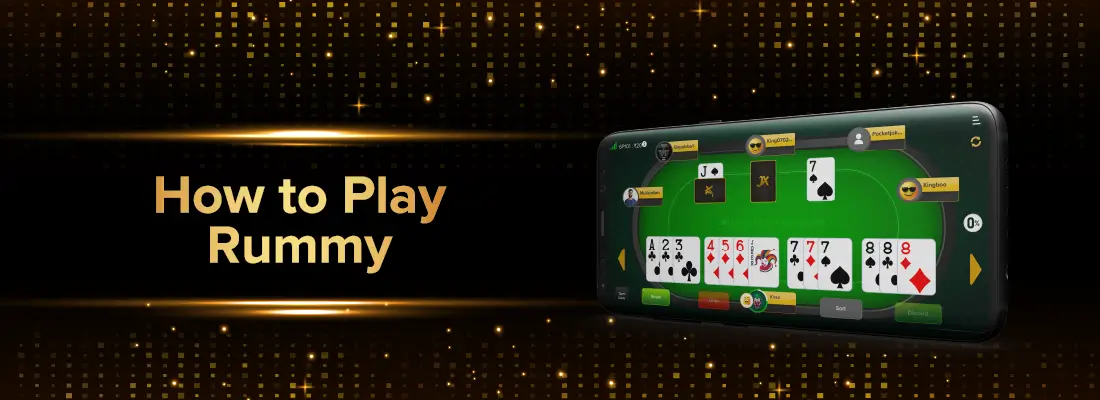How to Play Rummy: Get Started With Indian Rummy Rules
Engaging in the online rummy card game offers a delightful and strategic experience. To learn how to play, it is essential to acquaint yourself with the basic rules and strategies. Each participant is dealt 13 cards from a standard deck of 52 cards. The main goal is to form at least two sequences, with one of them being a pure sequence. The player who successfully declares a valid hand first emerges as the winner.
The Objective of Rummy Card Game
- In an online rummy card game, the primary goal is to form a minimum of two sequences, with one of them being a pure sequence. To achieve this, a standard deck of 52 cards is employed, and each player is dealt 13 cards. The player who successfully declares a valid sequence before anyone else emerges as the winner of the game.
- The unused cards are gathered to create a closed deck. This deck is positioned in the centre of the table, facing downwards and concealed from the players. To form the open deck, the top card from the closed deck is revealed and placed face up on the table. Players can now discard cards onto this open deck strategically.
- Furthermore, a random card is designated as the wild joker. Consequently, all the cards of the same rank but different suits also acquire the status of wild jokers during the game.
What Are Rules of Rummy?
The Indian Rummy rules are straightforward and can be easily grasped. Let's understand how to play Rummy game:
- In Indian Rummy, every player is dealt 13 cards, chosen randomly from a deck of 52 cards. The main goal is to form a minimum of two sequences, with one sequence being a pure sequence. To emerge victorious in Rummy, players should give utmost importance to creating a pure sequence. It is advisable to discard high-value cards early on if they cannot be grouped, while also keeping a close watch on the opponent's moves.
- In Rummy, it is necessary to create a minimum of two sequences for a valid declaration.
- Out of these two sequences, at least one must be a pure sequence.
- There are different ways to arrange the cards in a valid order, such as having 2 sequences and 2 sets, or 3 sequences and 1 set.
- Another valid arrangement is to have all the cards arranged in sequences.
- If you declare without a pure sequence in your hand, your penalty points will be calculated by adding up the points of all the cards in your hand, resulting in a significant margin of loss.
What is a Sequence?
Rummy is a game filled with intricacies, where sequences play a vital role. A sequence is formed by three or more consecutive cards of the same suit. These sequences can be categorized as pure or impure. To excel in the game, players must make strategic decisions about utilizing wild jokers while also preserving the purity of their sequences. This delicate balance is key to success in rummy.
Pure Sequence
Creating a pure sequence is the pinnacle of rummy mastery. It involves arranging consecutive cards of the same suit without any joker substitutions. This artful skill is essential for making a valid declaration in the game of rummy. Let's explore some examples to better understand the significance of a pure sequence and how it adds to the overall gameplay experience.
Examples of Pure Sequence

This is a sequence composed of 5♦-6♦-7♦ These three consecutive diamond cards form a pure sequence, and it's worth noting that no joker has been brought into play here.
Take a look at the sequence 2♣-3♣-4♣-5♣. This arrangement consists of four consecutive club cards, creating a pure sequence. Remarkably, no joker has been introduced into this sequence.
A delightful pure sequence featuring the cards 6♥-7♥-8♥-9♥-10♥. These five consecutive heart cards are seamlessly aligned to form a pure sequence, and it's important to highlight that no joker has been employed in the creation of this sequence.
In a pure sequence, a wild joker retains its original value and can be used, but only if it belongs to its original suit. It cannot substitute for any other card. Let's look at this example: 7♥-8♥-9♥ (WJ).
Example of Pure Sequence (With a Wild Joker)
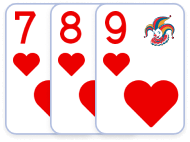
Imagine, the 9 of Hearts (9♥) serves as a wild joker. However, it's essential to note that the sequence remains a pure sequence. This is because the 9 of Hearts is not being utilized as a joker to substitute for any other card in the sequence. Instead, it retains its original value (9) and functions as a card of its original suit (♥).
Use this approach especially when you find yourself in possession of several wildcard jokers.
When you don't have many wild jokers, it's best to use them for making mixed sequences and sets.
Impure Sequence
In Rummy, an impure sequence refers to a sequence of three or more cards arranged consecutively, where one or more cards have been substituted with a joker or jokers.
Examples of Impure Sequence
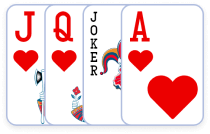
J♥-Q♥-PJ-A♥ (This sequence is impure, as the printed joker substitutes for the King of Hearts.)
2♠-3♠-7♦ (WJ) (This is an impure sequence, where the 7 of Diamonds acts as a wild joker, substituting for the 4 of Spades.)
What is a Set?
A set is formed when three or four cards of the same rank come together, even if they belong to different suits. Sets are crucial elements of a player's strategy as they can be completed by using jokers to replace missing cards. By embracing the use of jokers, players can enhance their arsenal and strengthen their hand in the game of Rummy.
Examples of Valid Sets (Without a Joker)

5♦-5♥-5♠ (This combination comprises sevens from three distinct suits.)
4♦-4♠-4♥-4♣ (This arrangement consists of twos from four diverse suits.)
Examples of Valid Sets (With a Joker)

The set consists of 3♣-3♠-Q♥ (WJ). In this arrangement, the Q♥ serves as a wild joker.
This set includes 7♦-7♠-7♥-(PJ). It's important to note that the printed joker is optional in this case. Even without the joker, the set remains complete as it encompasses all the 7s from different suits.
Comprising K♣-(PJ)-K♦, this set utilizes the printed joker to substitute the missing cards, K♥ or K♠.
The set is formed by 4♣-4♠-3♥ (WJ). Notably, the 3♥ functions as a wild joker in this particular combination.
Example of Invalid Set
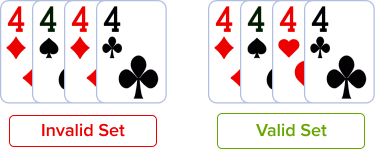
4♦-4♠-4♦-4♣ (According to the rules of rummy sets, this arrangement does not meet the criteria for a valid set. It is considered invalid due to the presence of two 4♦ cards. Had it included 4♥ in place of one of the 4♦ cards, it would have formed a valid set. A proper example of a valid set is: 4♦-4♣-4♠-4♥.)
Example of Invalid Set
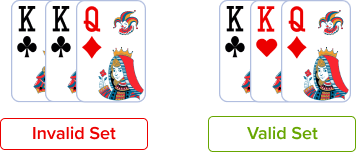
K♣-K♣-Q♦ (WJ) (This set is considered invalid since it contains two K♣ cards. To create a valid set, simply replace one of the K♣ cards with either K♦ or K♥. Examples of valid sets include: K♣-K♦-Q♦ (WJ), K♣-K♥-Q♦ (WJ).)
Importance of Jokers in Rummy
Mastering the use of jokers is a crucial skill in the game of rummy. Jokers, categorized into printed and wild types, hold a unique significance and can significantly contribute to your victory in the game. Understanding their roles is a fundamental aspect of playing rummy effectively.
Printed Joker
A printed joker is a card featuring the image of a joker. Its purpose is to serve as a replacement for any absent card, aiding in the creation of sets or impure sequences. To better grasp the utilization of a printed joker in rummy, observe the examples of an impure sequence and a set provided below.
Examples of Impure Sequences with Printed Joker

7♥-8♥-(PJ) (The printed joker is utilized to substitute for the 9♥ of Hearts in this impure sequence.)
4♠-4♦-PJ (The printed joker is employed to stand in for either the 4♣ of Clubs or the 4♥ of Hearts in this set.)
Wild Joker
In the initial phase of the game, a random card is designated as the wild joker. Once selected, this specific card, along with other cards sharing the same rank but differing suits, assumes the role of the wild joker for the entire game. Similar to the printed joker, the wild joker serves as a versatile substitute for any absent card, facilitating the creation of sequences or sets.
Examples of Impure Sequences with Wild Joker

5♣-6♣-8♣-7♦(WJ) (The 7♦ serves as a wild joker in this sequence, making it an impure sequence.)
2♠-2♥-4♣ (Here, the 4♣ acts as a wild joker, substituting either 2♣ or 2♦ in the set.)
Rules of Rummy for Making a Valid Declaration
Valid Declaration
To make a valid declaration in the game of rummy, players need to arrange all 13 cards in their hand following the game rules. This involves forming sequences or sequences and sets. Once the cards are organized, players must discard one unwanted card into the designated "Finish" slot and declare their hand to end the game. The player who accomplishes a valid declaration first is declared the winner and receives zero points.
To successfully declare in the game of rummy, there are three key conditions that need to be met:
- Pure Sequence: In the game of rummy, a pure sequence is crucial for victory. To create a pure sequence, players must arrange at least three consecutive cards of the same suit without using a printed joker as a substitute. However, a wild joker can be used in a pure sequence if it belongs to the same suit. If a player fails to form a pure sequence, any declaration made is considered invalid, resulting in a loss equivalent to the total value of all the cards in their hand.
- Second Sequence: To successfully declare in rummy, players must adhere to the game's rules and create at least two sequences. These sequences consist of a mandatory pure sequence and a second sequence, which can be pure or impure depending on the cards in hand. An impure sequence involves the use of a joker as a substitute for any other card in the sequence. It is worth mentioning that players have the flexibility to form more than two sequences if desired.
- In the game of rummy, it is crucial to organize the cards in your hand effectively to make a valid declaration. Apart from the mandatory two sequences, all the remaining cards must be arranged in either sequences or sets. While forming a set is optional, it is important to ensure that all the cards are included in a valid combination.
Invalid Declaration
If a declaration fails to meet any of the three conditions mentioned earlier, it will be considered invalid. In such cases, the player who made the invalid declaration will lose instantly, and the opponent will be declared the winner in a two-player game. However, if there are more than two players, the game will continue until one of the remaining players makes a valid declaration. Here are a few instances of declarations that would be considered invalid.
How are Points Calculated in a Indian Rummy Rules?
| Cards | Value |
|---|---|
| Printed Joker and Wild Joker | Zero points each |
| High-Value Cards: Ace, King, Queen, Jack | 10 points each |
| Numbered Cards: 2, 3, 4, 5, 6, 7, 8, 9, 10 | Worth their face value |
Penalty Points for Losing Players
| Type of Drop | Penalty Impact |
|---|---|
| First Drop | Penalty of 20 points |
| Middle Drop | Penalty of 40 points |
| Wrong or Invalid Declaration | Penalty of 80 points (max. penalty) |
| Declaring a valid hand second | 2 points |
Important Terms to Know for Understanding Rules of Rummy
Acquainting oneself with rummy terminology enriches the gaming experience. From table dynamics to actions like draw, discard, meld, and drop, each term contributes to a player's comprehensive understanding of the game.
- Rummy Table: To play rummy online, start with a free practice game at a virtual table. Usually, two to six players can join.
- Sorting of Cards: At the game's start, click "Sort" to automatically arrange your cards by suit. This helps spot potential combinations like sequences and sets.
- Deal/Round: A round kicks off with card dealing and concludes when a player declares their hand.
- Dealing of Cards: Cards are distributed randomly to players at the game's start.
- Draw and Discard: In each turn, pick a card from the closed or open deck and discard an unwanted one from your hand.
- Meld: After dealing, arrange your cards in valid sequences or sets. This arrangement is called melding.
- Printed & Wild Joker: Jokers, vital in rummy, come in two types: printed jokers (1 per deck) and wild jokers (4 per deck). Both can replace missing cards in sets or sequences.
- Drop: You can opt out of the game anytime, known as a drop. There are penalty points for dropping, depending on when you drop.
- Chips: Use chips for practice games on RummyJax. You receive free chips upon registration and can reload when needed.
- Declare: After discarding to the "Finish" slot, reveal your cards to opponents – this is declaring your hand.
- Cash Tournaments: Join cash tournaments by paying an entry fee on RummyJax. Winners receive real money prizes, making it an exciting way to play rummy online. Simply add cash to your RummyJax account and start playing!
Rules of Rummy FAQs
In a Rummy game, the golden rule is to make groups of cards and put them in order to have as few points as possible. Get rid of cards that don't belong to any group. When you're prepared, let everyone know.
In 13 Cards Rummy, everyone gets 13 cards. The main rule is to make groups of cards in the right order. You must have a set of cards which is a pure sequence, without using Jokers.
To play and win Rummy, make groups of cards that go together, like numbers in order or cards with the same number. Try to get rid of cards that have a lot of points. When you have the right sets, show your cards. The person with the fewest points at the end is the winner.
